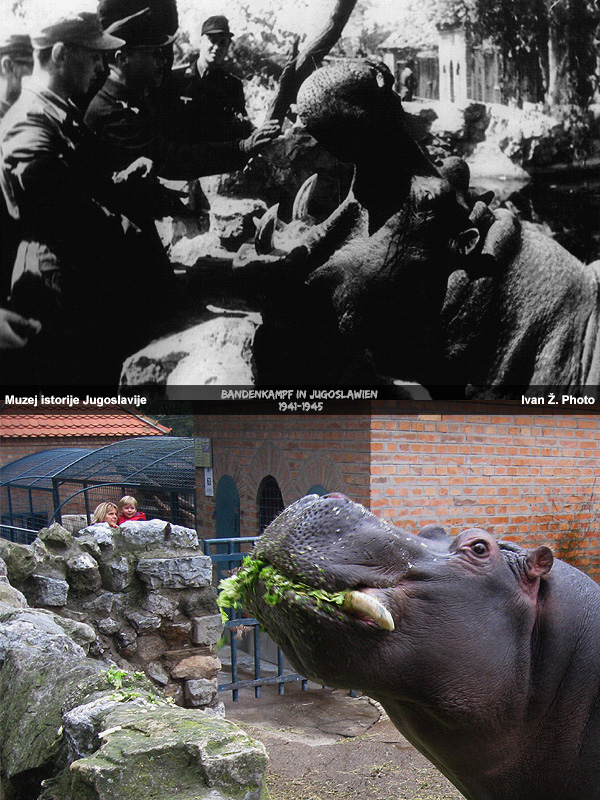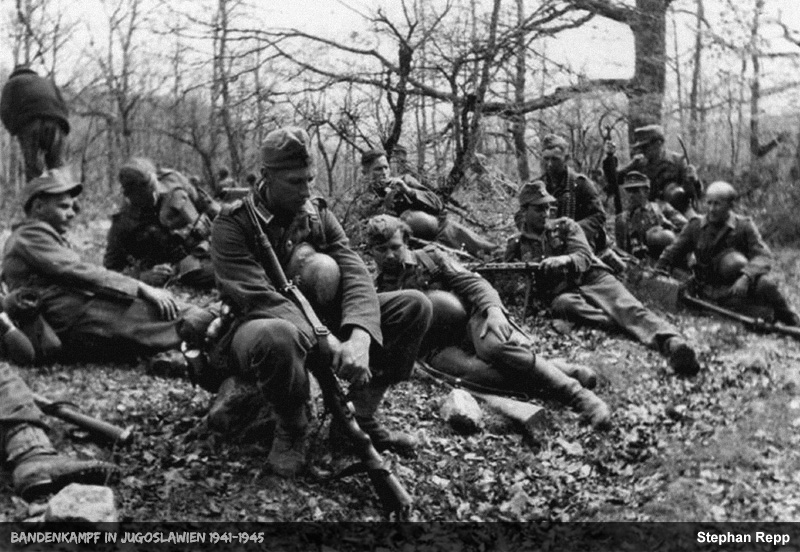
Then and now: Belgrade Zoo. This year, 2016, marks the 80th anniversary of the Belgrade Zoo, once one of the favourite places even of the Yugoslav royal family. The zoo advanced extremely well from the start, and it quadrupled its size in a very short period of time. Unfortunately, only five years after foundation, the progress was stopped by the German – and then put an end to by the Allied bombing. The zoo was halved in size (and to date remains the same), and most of the animals were killed. Among the few who survived the war, there were hippo Buca and alligator Muja. In the (old) photo, in the period between the two bombings, members of the German tropical and armoured troops play with Buca, back then the most popular animal of the zoo. Buca particularly liked his teeth to be scratched, and he opened his mouth on the command "Open your mouth, Buca!" After the war, he was rewarded with a girl, Julka, with whom he had his only offspring, Nidža. None of them is among the living any more; however, there is another Julka and another Nidža living in the Belgrade Zoo now, who recently had a baby too (just a few days before the second enclosed photograph was taken). Still living next to them is the old alligator Muja, officially the oldest alligator in the world. And the German soldiers are long gone from Belgrade – although some of their vehicles are still parked just a few hundred metres from the zoo, but this time as historical exhibits, and a reminder of a horrible time.
Text: Ivan Ž.
Photographer: a) unknown; b) Ivan Ž.
Date: a) 1942/1943; b) October 2015.
Location: a) Belgrade, Yugoslavia; b) Belgrade, Serbia.
Original caption: a) unknown; b) no caption.
File source: a) Muzej istorije Jugoslavije / Znaci, 7571; b) Ivan Ž.
NOT ALLOWED: removing source credits from the files – using text without crediting the original author – using files and information for political propaganda and commercial purposes.
Onda i sada: Beogradski zoološki vrt. Ove, 2016. godine navršava se 80 godina od osnivanja Beogradskog zoološkog vrta, nekada jednog od omiljenih mesta čak i članova jugoslovenske kraljevske porodice. Vrt je od početka izuzetno dobro napredovao, i za vrlo kratko vreme je učetvorostručio svoju površinu. Nažalost, samo pet godina po osnivanju, napredak je zaustavljen nemačkim – a potom dokusuren savezničkim bombardovanjem. Površina vrta je prepolovljena (i do danas je ostala ista), a većina životinja je pobijena. Među retkima koji su preživeli rat bili su nilski konj Buca i aligator Muja. Na (staroj) slici, u periodu između dva bombardovanja, pripadnici nemačkih tropskih i oklopnih jedinica igraju se sa Bucom, tada najpopularnijom životinjom zoo vrta. Buca je posebno voleo da ga češkaju po zubima, i otvarao je usta na komandu "Zini, Buco!" Posle rata je nagrađen devojkom, Julkom, s kojom je dobio svog jedinog potomka, Nidžu. Danas više niko od njih nije među živima; međutim, u Beogradskom zoološkom vrtu sada žive jedna druga Julka i jedan drugi Nidža, koji su nedavno dobili i bebu (samo par dana pre nego što je napravljena ovde druga priložena fotografija). Pored njih i dalje živi stari aligator Muja, zvanično najstariji aligator na svetu. A nemačkih vojnika u Beogradu odavno nema – iako neka od njihovih vozila još uvek stoje parkirana samo par stotina metara od zoo vrta, ali ovog puta kao istorijski eksponati, i podsetnik na jedno strašno vreme.
Tekst: Ivan Ž.
Fotograf: a) nepoznat; b) Ivan Ž.
Datum: a) 1942/1943; b) oktobar 2015.
Mesto: a) Beograd, Jugoslavija; b) Beograd, Srbija.
Originalni natpis: a) nepoznat; b) bez natpisa.
Izvor fajla: a) Muzej istorije Jugoslavije / Znaci, 7571; b) Ivan Ž.
NIJE DOZVOLJENO: uklanjanje naziva izvora sa fajlova – korišćenje teksta bez navođenja izvornog autora – korišćenje fajlova i informacija u političko-propagandne i komercijalne svrhe.










